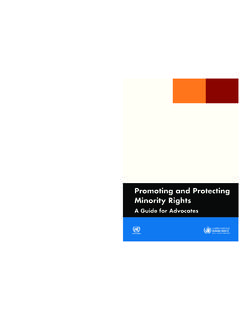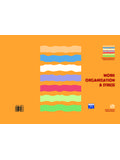Transcription of The Role of the Justice System - United Nations Office on ...
1 Handbook on Children Recruited and Exploited by Terrorist and Violent Extremist Groups:The Role of the Justice SystemCover photo: on Children Recruited and Exploited by Terrorist and Violent Extremist Groups:The Role of the Justice SystemUNITED Nations Office ON DRUGS AND CRIMEV iennaUNITED NATIONSV ienna, 2017 United Nations Office on Drugs and Crime, 2017 The designations employed and the presentation of material in this publication do not imply the expression of any opinion whatsoever on the part of the Secretariat of the United Nations concerning the legal status of any country, territory, city or area or of its authorities, or concerning the delimitations of its frontiers or boundaries. Mention of firm names and com-mercial products does not imply the endorsement of the United production: English, Publishing and Library Section, United Nations Office at ..vIntroduction ..1A. Challenges ..3B. The Handbook ..4C. Terminology ..7 Chapter 1. Strategies for preventing recruitment of children by terrorist and violent extremist groups.
2 9A. Recruitment and exploitation of children ..10B. Adopting a holistic approach: preventing violence against children ..16C. Preventing recruitment of children by terrorist and violent extremist groups ..21 Chapter 2. Child victims of recruitment and exploitation: their treatment in the Justice System ..39A. Recognizing as victims children recruited and exploited by terrorist and violent extremist groups ..40B. Protecting child victims and witnesses during investigations and trials ..47C. The right of child victims to reparation ..58 Chapter 3. Justice for children accused of terrorism-related offences ..69A. Specialized juvenile Justice System ..70B. Pretrial stage ..82C. Trial and sentencing ..90D. Children deprived of their liberty ..97 Chapter 4. Rehabilitation and reintegration of children recruited and exploited by terrorist and violent extremist groups ..105A. Reintegration of children recruited and exploited by terrorist and violent extremist groups.
3 106B. Promoting comprehensive reintegration policies and programmes ..110C. Demobilization and release ..121D. Cross-border cases ..129E. Rehabilitation and reintegration as a key purpose of the Justice process ..135 Annex. Relevant international legal framework ..144vvAcknowledgementsThe preparation of this Handbook was made possible by the cooperative efforts and invaluable contributions of several individuals and United Nations Office on Drugs and Crime (UNODC) wishes to extend its gratitude to the Member States who contributed to the consultation process. UNODC is grateful to the Chairs of the regional groups for identifying experts to participate in the expert group meeting on the treatment by the Justice System of children recruited and exploited by terrorist and violent extremist groups, held in Vienna from 13 to15 December is grateful to the participants of the expert group meeting for their extensive contributions.
4 In particular, UNODC is most thankful to Carolyn Hamilton for her invaluable background research and substantive input. The experts who attended the meeting were Mahmood Fadhil Masyab Al Bayati, Abdelaziz Ahmed Abdalla Alhajri, Jamie Bell, Abderezak Bensalem, Sofiane Bessadok, Hanae Boughdad, Haffide Boulakras, James Cooke, Valerio de Divitiis, Swen Dornig, Hamza Essaid, Abdoul Kassim Fomba, Imma Guerras Delgado, Carolyn Hamilton, Ibrahim Jean Etienne, Rose Marie Kerkor, Kai Li, Carlos Magad n Mart nez, Angela McCabe, Rolando Melo Latorre, Tim Molyneux, Na ma M ller, Rose Oka Oji, Siobhan O Neil, Reynante Orceo, Alexandra Ott M ller, Daniel Palmer, Stephen Ramwell, Guenther Sablattnig, Ibrahim Sesay, Dmitry Titov and Renate Winter. The following UNODC staff members contributed to the meeting: Aldo Lale-Demoz, Val rie Lebaux, George Puthuppally, Ulrich Garms, Alexandra Martins, Anna Giudice and Giulia Melotti. The Handbook was written by Giulia Melotti, Alexandra Martins, Ulrich Garms and Katharina Peschke, using as a basis the contributions of the expert group meeting.
5 The production of the Handbook was guided by: Val rie Lebaux, Chief of the Justice Section, Division of Operations; George Puthuppally, Chief of Implementation Support Section II (Sub-Saharan Africa) in the Terrorism Prevention Branch; and Mauro Miedico, Acting Chief of the Terrorism Prevention Branch, Division for Treaty Affairs. UNODC is grateful to the following individuals for their comments on and contributions to the draft-ing of the Handbook: Renate Winter, Stephan Husy, Na ma M ller, Imma Guerras-Delgado, Alexandra Ott M ller, Merel Molenkamp, Irina Scheitz, Jessika Soors, Abdoul Kassim Fomba, Rose Marie Kerkor, James Cooke, Tim Molyneux, Aimee Comrie, Panagiotis Papadimitriou, Anna Giudice, Dayan Farias Picon, Rouzbeh Moradi and Rohan is most grateful to the Governments of Austria, Canada, Denmark and Switzerland for providing the funding to enable the development, translation into Arabic and French, reproduction and dissemination of this Handbook.
6 11 IntroductionIn the past few years, the international community has been increasingly confronted with the recruit-ment and exploitation of children by terrorist and violent extremist groups. Numerous reports have shed some light on the extent of this disturbing indicate that, since 2009, about 8,000 children have been recruited and used by Boko Haram in According to a report of the United Nations High Commissioner for Human Rights, some boys have been forced to attack their own families to demonstrate loyalty to Boko Haram, while girls have been forced to marry, clean, cook and carry equipment and weapons. The Office of the United Nations High Commissioner for Human Rights received consistent reports that some boys and girls were increasingly being used as human shields and to detonate bombs. In May 2015, for example, a girl about 12 years old was used to detonate a bomb at a bus station in Damaturu, Yobe State, killing seven people.
7 Similar incidents were reported in Cameroon and the Niger. During attacks by Boko Haram, abducted boys were used to identify those who refused to join the group , as well as unmarried women and 2015 alone, the United Nations verified 274 cases of children having been recruited by Islamic State in Iraq and the Levant (ISIL) in the Syrian Arab Republic. The United Nations verified the exist-ence of centres in rural Aleppo, Dayr al-Zawr and rural Raqqah that provided military training to at least 124 boys between 10 and 15 years of age. Verification of the use of children as foreign fighters has increased significantly, with 18 cases involving children as young as 7 years of age. The use of children as child executioners was reported and appeared in video footage. In Iraq, in two incidents in June and September 2015, more than 1,000 children were reportedly abducted by ISIL from Mosul While the lack of access to areas in conflict undercuts the possibility to gather precise data, it is known that recruited children were used to act as spies and scouts, to transport military supplies and equip-ment, to conduct patrols, to man checkpoints, to videotape attacks for propaganda purposes and to plant explosive devices, as well as to actively engage in attacks or combat figures are likely to be significant underestimates because of the limited opportunities to gain access and monitor violations against children.
8 Child recruitment is also perpetrated by Al-Shabaab in Kenya and Somalia,5 by the Movement for Unity and Jihad in West Africa, Ansar Eddine and Al-Qaida in the Islamic Maghreb in Mali and neighbouring countries and by the Abu Sayyaf group in the Philippines,6 to name a few. Owing to the expanding reach and propaganda of terrorist and violent extremist groups, child recruitment and exploitation are in no way limited to conflict-ridden areas. More and more children are travelling from their State of residence to areas controlled by terrorist and violent extremist groups, in order to join them. They may travel with their families or by themselves, and obtaining comprehen-sive data on their participation in hostilities is often difficult. In the case of ISIL, for instance, informa-tion often becomes available only after the children s death, when they are eulogized as martyrs and their country of origin is Data collected for more than one year, during the period 2015-2016, concerned 89 children who died in hostilities.
9 They included not only nationals of Iraq and the Syrian Arab Republic, but also nationals of Australia, France, Lebanon, Libya, Morocco, Nigeria, Saudi Arabia, 1 Report of the Secretary-General on children and armed conflict in Nigeria (S/2017/304), paras. 29 and Report of the United Nations High Commissioner for Human Rights on violations and abuses committed by Boko Haram and the impact on human rights in the affected countries (A/HRC/30/67), para. Children and armed conflict: report of the Secretary-General (A/70/836-S/2016/360), paras. 65, 149 and Report of the Secretary-General on children and armed conflict in Iraq (S/2015/852), para. A/70/836-S/2016/360, para. Report of the Secretary-General on children and armed conflict in the Philippines (S/2017/294).7 Mia Bloom, John Horgan and Charlie Winter, Depictions of children and youth in the Islamic State s martyrdom propa-ganda 2015-2016 , CTC Sentinel (February 2016).2 CHILDREN RECRUITED AND EXPLOITED BY TERRORIST AND vIOLENT EXTREMIST GROUPS: ROLE OF THE Justice SYSTEM2 CHILDREN RECRUITED AND EXPLOITED BY TERRORIST AND vIOLENT EXTREMIST GROUPS: ROLE OF THE Justice SYSTEMthe Sudan, Tajikistan, Tunisia, the United Kingdom of Great Britain and Northern Ireland, and Yemen.
10 These figures do not include children taken to ISIL territory by their families. Finally, children may also be recruited to support the groups, or even carry out attacks, in countries that are not experiencing armed priority on the international agendaChildren who have been recruited and exploited by terrorist and violent extremist groups are victims of violence at multiple levels. They are often victims of extreme violence during their association with the group ; which includes ferocious recruitment methods, enslavement, sexual exploitation, exposure to constant fear, indoctrination and psychological pressure. They are often injured or killed in combat. At the same time, because of their young age and psychological malleability, such children may become particularly dangerous instruments of the groups that recruited them, as the children may be used for committing criminal offences, including, in certain cases, acts of terrorism, war crimes or crimes against of the variations of the phenomenon, according to the international legal framework, the recruitment and exploitation of children by terrorist and violent extremist groups are to be consid-ered a serious form of violence against the nature and gravity of violence against those children may vary from case to case, the short- and long-term implications for both children and society as a whole are severe.












